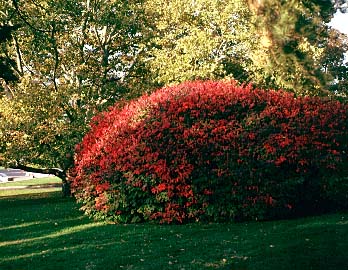

One of the most striking examples of fall foliage will soon be seen throughout our campus in the form of the popular shrub Euonymus alata, the Winged Euonymus, or Burning Bush. Groupings of these vivid scarlet shrubs can be seen in several places on campus: surrounding the service parking area directly behind Hedrick hall; at the top end of the Rock garden facing North street; to the left of the PGRU building facing the Fleet garage parking lot; and in the shrub grouping between the water tower and Station pavilion. These shrubs are members of the Celastraceae or Bittersweet family, a widespread group of about 700-900 species, most from tropical and subtropical regions, with some members in temperate North America, Europe and Asia.
Euonymus, a large genus with 175 species of trees and shrubs scattered from the Himalayas to China and Japan, is one of the 55 genera in the bittersweet family. Six Euonymus species are commonly found in eastern North America. Native species include Burning Bush or Eastern Wahoo, (E. atropurpureus), Strawberry Bush (E. americanus) and Running Strawberry Bush (E. obovatus). The introduced species include Winged Euonymus(E. alata), from eastern Asia, Spindle Tree (E. europaeus) and Wintercreeper (E. fortuneii), from Europe. Common characteristics of all 6 species are the structure of flowers and fruits, the opposite paired leaves, and four-sided twigs.
Easiest to recognize is our campus' Winged Euonymus (E. alata)-
no other shrub in the East has those thin, blade-like corky ridges on the
4 sides of its twigs. It is an eye catcher from all directions, with its
brilliant red to translucent pink fall color, and red fruits with purple
arils (berry-like capsule or seed covering). It becomes a  medium-sized, broad round shrub with stiff stratified horizontal
branches, and it can reach 9 feet in height.
medium-sized, broad round shrub with stiff stratified horizontal
branches, and it can reach 9 feet in height.
Wintercreeper (E. fortuneii) is evergreen, with its thick glossy green leaves retaining their bright color throughout the winter. It is also unique in that can grow as a trailing rooting shrub or a vine that can climb up to 20 feet high by adhesive aerial rootlets erupting from new green stems. The fruits are bright orange, covered by a smooth white aril. These shrubs are popular as foundation plantings and come in many horticultural varieties. Regrettably, this species is a favorite for scale insects, which may decimate the shrubs over time.
The Strawberry Bushes are best recognized for their green four-sided twigs and unique fruit. They are also called Bursting-heart Bush as their bright orange fruits seem to explode out of their covering. The two forms of Strawberry Bush can be differentiated by leaf shape and habit. Running Strawberry Bush, with its trailing habit, is a low shrub up to one foot tall that root at leaf joints and thus forms dense mats; its leaves are widest near the tip. Strawberry Bush is an upright medium sized shrub of straggling habit to eight feet and has evenly lanceolate leaves.
Our native Burning Bush (Eastern Wahoo) and introduced (European) Spindle Tree are similarly unique in their fruit appearance-which closely resembles popcorn attached by long thin stalks to the twigs. Eastern Wahoo, with its scarlet arils and purple fruits, can be easily distinguished from Spindle Tree with its orange arils and pink fruits. Eastern Wahoo's species name "atropurpureus" means dark purple and refers to its fruit color. Both these Burning Bushes are upright shrubs with elegant symmetry and branching. Eastern Wahoo is extremely hardy, often planted along roadsides and highways for its bright red fall color. It is a fast-growing, short-lived, large shrub or small tree with wide, flat-topped irregular crown to 25 feet. It occurs commonly in open woodlands and woodland borders, in thickets and ravines, and on hillsides. Spindle Tree or European Euonymus is a large, vigorous, bushy, upright shrub or small tree to 25 feet.
The genus name Euonymus means "of auspicious name," referring to supposed medicinal qualities of many of the species. NOT! Most, like our Eastern Wahoo, contain strong purgatives and laxatives which were used by American Indians and pioneers for this purpose (hence the name "Wahoo"!). This use sometimes resulted in internal damage and the plant was subsequently banned for medicinal use by the US FDA. The seeds, twigs, and leaves can also be toxic and potentially fatal to livestock that feed on them. Both bark and roots contain compounds similar to those found in foxglove. Euonymus wood is a favorite of sculptors. Artists prefer this wood also for charcoal making. Euonymus bark was often used in tanning fine leathers.
The name Euonymus remains appropriate and "auspicious" in their use as ornamentals, because of their attractive fall foliage, unique colorful 4 lobed or 4-celled fruit and four-sided ridged twigs. Our local Euonymus flower from May to June and their fruits persist on slender stems throughout the winter.
Consider one or more Euonymus species as a delightful fall and winter contrast to add to your home landscape.
by Cathy Heidenreich
Next (Douglas Fir)
Return to Arboretum Home Page
Return to NYS Agricultural Experiment Station Home Page